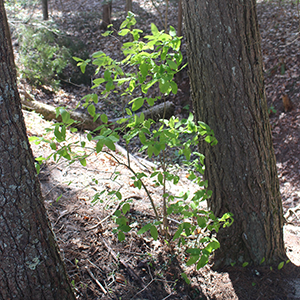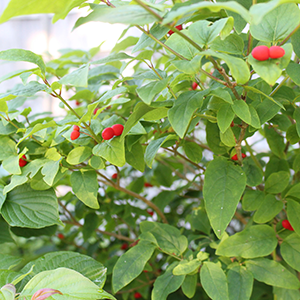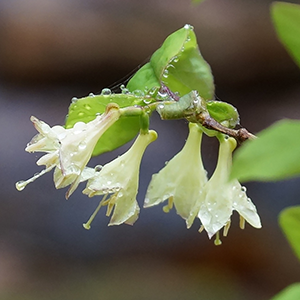American honeysuckle (Lonicera canadensis)
Small to medium-sized shrub of woodlands and mixed forest edges; dangling, bell-shaped, paired flowers and lovely green leaves appear simultaneously in mid to late spring; attractive red fruit in early autumn. Ranges from Nova Scotia and eastern Saskatchewan, south to Pennsylvania, west to Minnesota: also found in high elevations of North Carolina
 An encounter with American honeysuckle (Lonicera canadensis) is always serendipitous. Mid-spring is an optimal time to search for this demure woodlander. Very little else in the understory layer is in full leaf when American honeysuckle has its cameo.
An encounter with American honeysuckle (Lonicera canadensis) is always serendipitous. Mid-spring is an optimal time to search for this demure woodlander. Very little else in the understory layer is in full leaf when American honeysuckle has its cameo.
And yet this is a native shrub that gets little attention or praise. American honeysuckle is often dismissed as straggling, scrawny, or unkempt. Michael Dirr impugns the whole genus when he writes, “[h]oneysuckles are like sheep; there are too many of them, all look alike, and they are rather pedestrian . . . they offer a sameness that does not inspire”.[i] His assessment isn’t fair to American honeysuckle (or to sheep).
Dirr does not even list Lonicera canadensis in his encyclopedic Manual of Woody Landscape Plants. This isn’t surprising because there is general neglect of this forest beauty in horticultural literature. Though two other native shrub honeysuckles, bush-honeysuckle (Diervilla[ii] lonicera) and Southern bush-honeysuckle (Diervilla sessilifolia) have recently become commercially available, and quite popular, nurseries and wholesale propagators do not seem interested in Lonicera canadensis. Even William Cullina in Native Trees, Shrubs and Vines gives only a short sentence to American honeysuckle and calls it “scraggly”.[iii]
There are approximately 180 Loniceras in the Northern hemisphere. Some are vines; some are shrubs. Many honeysuckles are notable for their precocious, and persistent, foliage: unfortunately, the “green mist of . . . unfolding leaves in still-bare wood and thickets” [iv] is too often boorish, naturalized colonies of Asian shrub honeysuckles. These non-native ornamentals have absconded from gardens and intentional plantings (including miles-long “scenic” installations beside highways, and restoration efforts encouraged by the U.S. Department of Agriculture through state Co-operative Extension programs).
But long before interstate beautification in the 1960s and 1970s, Asian shrub honeysuckles could be found in New England dooryard gardens mingling with lilacs, weigelas, and beautybushes. These exotic ornamentals were often part of the returning cargo from the nineteenth-century China Trade. The Asian shrub honeysuckles were probably in some East Coast gardens as early as the late-eighteenth century. Andrea Wulf in Founding Gardeners, writes that Thomas Jefferson and James Madison, botanizing near Lake George in the Adirondacks, in 1791, were “amazed to find ‘honeysuckle of the gardens’ (most certainly Lonicera canadensis) growing wild on the banks of one lake”.[v] They undoubtedly found the native woodlander, but confused it with an Asian cousin seen in a garden in Virginia or Pennsylvania.
 In Maine it is not unusual to find Tatarian honeysuckle (Lonicera tatarica), Morrow’s honeysuckle (L. morrowii) or Amur honeysuckle (L. maackii) in old fields, and proliferating in nearby woods. These foreign relatives of Lonicera canadensis are generally more robust. They produce taller, more vigorous stems, and have plentiful fruit which birds transport elsewhere, often deep into woodlands. The leap-frogging redistribution of seeds continues until only deepest shade prevents flowering (and fruit production).
In Maine it is not unusual to find Tatarian honeysuckle (Lonicera tatarica), Morrow’s honeysuckle (L. morrowii) or Amur honeysuckle (L. maackii) in old fields, and proliferating in nearby woods. These foreign relatives of Lonicera canadensis are generally more robust. They produce taller, more vigorous stems, and have plentiful fruit which birds transport elsewhere, often deep into woodlands. The leap-frogging redistribution of seeds continues until only deepest shade prevents flowering (and fruit production).
 Lonicera canadensis on the other hand, exults in shade and filtered light. Its leaves and flowers appear early while canopy trees are not in full leaf. This adventitious greening distinguishes American honeysuckle from other native understory shrubs; its delicate leaves are like virescent brushstrokes, emerald dabs against fine, pale branches. Small, paired, lightest yellow flowers are pendent below the leaves. The flowers are tubular, like tiny trumpets and their shapes invite the ministrations of moths, most importantly the Sphingidae, the sphinx or hawk moths.
Lonicera canadensis on the other hand, exults in shade and filtered light. Its leaves and flowers appear early while canopy trees are not in full leaf. This adventitious greening distinguishes American honeysuckle from other native understory shrubs; its delicate leaves are like virescent brushstrokes, emerald dabs against fine, pale branches. Small, paired, lightest yellow flowers are pendent below the leaves. The flowers are tubular, like tiny trumpets and their shapes invite the ministrations of moths, most importantly the Sphingidae, the sphinx or hawk moths.
The snowberry clearwing (Hemaris diffinis) and the hummingbird clearwing (Hemaris thysbe) both resemble large bumblebees. Their hovering flights during feeding is hummingbird-like; their elongate tongues can probe the honeysuckle flower’s nectary. The clearwing moths (a subfamily of the Sphingidae) like most sphinx moths, have green, horned caterpillars. We are conditioned to alarm by the presence of large, green horned caterpillars on tomato plants. But not every horned caterpillar is a villain. In fact, most moth and butterfly larvae (caterpillars) are dietary specialists, and it is always wise to identify what is encountered before overreacting. (Even with tomato hornworms, Manduca quinquemaculata, caterpillars should be examined-before removal for the presence of the visible cocoons of a braconid wasp, Cotesia congregata; the wasp’s larvae consume the hornworm as they tunnel outward to continue their life cycles.)
Mellitophilous bees, members of the Andrenidae, Osmia, and Halictidae families also pollinate American honeysuckles. These are the mining, mason, and sweat bee, some solitary, some semisocial, who are abundant in springtime. Their sizes are appropriate for the delicate flowers of Lonicera canadensis. Bumblebees (Bombus species) may also rummage the blossoms for pollen and nectar, but they are oafishly less effective as pollinators.
There is not much to be found about the faunal associations of Lonicera canadensis. Most references turn out to be for other members of the genus. American honeysuckle’s fruit, seeded and rich red, is appealing to birds. But when the avian species list is examined- catbirds, cardinals, robins, blackbirds, blue jays, white-throated sparrows- it is clear that these are backyard frugivores, not woodland birds who would be nesting in Lonicera canadensis’s woody habitat. Brown thrashers, green-cheeked thrushes, ruffed grouse, and yellow-rumped warblers comprise a more appropriate roster.
Though the taxonomy of Lonicera canadensis is perfectly sound, it seems unfair that American honeysuckles should have to share a genus with more clamorous members. The Loniceras were named for a sixteenth-century German herbalist Adam Lonitzer (1528-1586) who revised Eucharis Rösslin’s 1557 herbal, the Kräuterbuch– not much of a tale there. The common name “honeysuckle” probably indicates the genus’s vines (not the shrubs) most of whom have larger flowers with more nectar, though variable in fragrance.
Only one other colloquial name turned up for American honeysuckle, the inexplicable “medaddy-bush” listed in Charlotte Erichsen-Brown’s 1979 Medieval and Other Uses of North American Plants. The dearth of common names usually indicates scant ethnobotanical usage.
The sparse literature, horticultural or scientific, on Lonicera canadensis doesn’t limn a very full portrait of a truly lovely plant. Two long shelves of books, accumulated over the past twenty-five years, on native/natural gardening yielded not a single mention of Lonicera canadensis Gardeners interested in ecological plantings rely not just on species’s lists, but on narratives about plants worthy of attention and worth their efforts.
Those who champion native plants are often confronted with the perception that wild species are not as beautiful as cultivated or exotic plants; showiness of bloom is the usual metric. Perhaps we do spend more time touting ecological values when we should attend to beauty as a motivation; it is beauty; after all, that lifted plants out of the purely utilitarian realm- when herb gardens became flower gardens.
I cannot list rare insects that might nibble and thrive only on American honeysuckle. Nor can I name a songbird whose numbers will rebound by propagating the shrub in our gardens. I can say that anytime I find Lonicera canadensis I stop to admire its glowing green bravery in the spring. I make pilgrimages to the nooks where it grows along the stream in my woods. I lift the slightly horizontal tracery of branches to look at the bell-like flowers. And I return mid-summer to admire the crimson fruit set off against still-bright green leaves.
Dylan Thomas wrote: “The force that through the green fuse drives the flower/ Drives my green age”. American honeysuckle is a Spring sentinel, and a green fuse, a small explosion of greenest green that lights up the woods and guides the season.
The cultural requirements of Lonicera canadensis are simple: humusy, well-drained soil, and cool shade. American honeysuckle is an understory shrub commonly found under the canopy of a mixed forest; its roots mingle comfortably with those of other shrubs and trees. Full shade is not a necessity; protection from strong afternoon sun in suggested.
The twin fruits ripen in July, and must be collected before they are spotted by birds! Put fruits in a small ziplock bag and squish to a mushy red pulp. They may stay like this for several days. Rinse seeds clean through a sieve, or by filling a bowl with water and pouring off the pulpy liquid. Sow immediately in a pot, seed flat or seed bed, cover with coarse sand and water regularly. Seeds usually germinate within a month. Let seedlings grow in a protected environment for a year before transplanting into the landscape.
By Pamela Johnson
[i] Dirr, Michael A., 1998. Manual of Woody Landscape Plants. Champaign, IL: Stackpole Publishing, LLC..
[ii] American “honeysuckles” fall into two genera, Diervilla and Lonicera, and there are shrub honeysuckles in both; Diervillas have fruiting capsules while Loniceras have fleshy fruits. Therein lies the taxonomic distinction.
[iii] Cullina, William. 2002. Native Trees, Shrubs and Vines. Boston: Houghton Mifflin Company; p.165.
[iv] Eastman, John. 1992. Forest and Thicket. Mechanicsburg, PA: Stackpole Books; p.180.
[v] Wulf, Andrea. 2011. Founding Gardeners. New York: Alfred A. Knopf. p.91.

